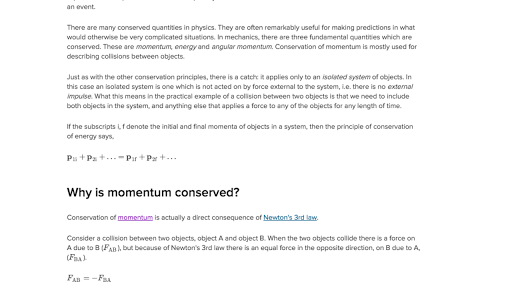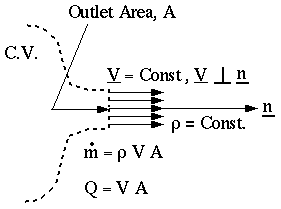Which Equation Best Describes the Law of Conservation of Momentum
12 It is a key result in quantum mechanics and its discovery was a significant landmark in the development of the subject. Newtons second law says.

Which Equation Best Describes The Law Of Conservation Of Momentum Brainly In
Matter cannot be created or destroyed in a chemical reaction B.

. The traditional approach is to derive teh NSE by applying Newtons law to a nite volume of uid. Benoit Paul Émile Clapeyron stated the ideal gas law in 1834 as a combination of the empirical Charless law. Force equals mass times acceleration F m x a.
As you will see to applying these principles to engineering calculations you will need two things. I a thorough understanding of the principles. We will also illustrate how these concepts can be used in engineering calculations.
However fluid dynamics literature often refers to the full. To know more visit BYJUS - The Learning App. Newtons second law can be describe by this equation Fmxa In this equation F is the force m is the mass and a is the acceleration.
For example if a person wanted to move a 10 kg object at an acceleration of 10 mss they would need to use a force equal to 100 Newtons. Simply put his law describes the relationship between the mass of an object the acceleration of an object and the force needed to move it. The equation is named after Erwin Schrödinger who postulated the equation in 1925 and published it in 1926 forming the basis.
Advertisement Momentum describes the force needed to stop objects and to. Reactants and products cannot escape from a closed system D. The Einstein Field Equation EFE is also known as Einsteins equation.
Law of Conservation of Momentum. Although the ideal gas law has several limitations it is a good approximation of the behaviour of many gases under many conditions. Which statement best describes the law of conservation of mass.
Technically they dont apply to semi-transparent objects like the atmosphere because the radiation isnt absorbed and emitted at weakly absorbed wavelengths often enough to create equilibrium. Historically only the equations of conservation of mass and balance of momentum were derived by Euler. The principle of conservation of energy for a particle or system of particles.
The law of conservation of momentum states that View Answer A 220 kg mirror with a 10 m2 surface are and a 98 is bombarded by right of average Intensity 7700 Wm2 at. To a good approximation momentum is conserved during the collision. Emissivity less than 1 allows.
The observation is in accordance with the first law. Conservation of momentum states that the total momentum before the collision is the same as the total momentum after the collision. Plancks Law and the derived S-B equation were derived for systems where radiation has come into equilibrium with the radiation that surrounds it.
Hence mass and energy can be converted from one form to another. Momentum is an important consideration in physics because it describes the relationship between speed mass and direction. The Law of conservation of.
The mass can neither be created nor destroyed. The Schrödinger equation is a linear partial differential equation that governs the wave function of a quantum-mechanical system. When the mass is measured.
The ideal gas law also known as the general gas equation is an equation of the state of a hypothetical ideal gas. Newtons second law states that the unbalanced force acting on an object is equal to the mass of the object times its acceleration. Newtons second law describes the relationship among force mass and acceleration.
Reactants in a chemical reaction rearrange to form a new substance or substances C. The Natural Resources Conservation Service NRCS National Engineering Handbook NEH Part 630 Chapter 4 includes a detailed discussion on updating the temporal distribution of rainfall based on the new NOAA Atlas 14 rainfall data from the older NRCS Type II-III distributions commonly used in Texas through 2019. The compressible Euler equations consist of equations for conservation of mass balance of momentum and balance of energy together with a suitable constitutive equation for the specific energy density of the fluid.
The law of conservation of mass and the law of conservation of energy was later amended by Einstein as the Law of conservation of mass energy which describes that the total mass and energy in a closed system remains constant. Law of conservation of momentum states that unless an external force is applied the two or more objects acting upon each other in an isolated system the total momentum of the system remains constant. This also means that the total momentum of an isolated system before is equal to the total momentum of the isolated system after.
This together with condition of mass conservation ie. The principle of conservation of angular momentum for a particle. Change of mass per unit time equal mass ux in minus mass ux out delivers the NSE in conservative form also known as Eulerian form as it refers to the mass-momentum balance as drawn by an observer at rest.
Einstein Field Equation gives a relationship between the mass and energy associated with the gravitation. TxDOT is evaluating whether to develop certain. The law of conservation of matter or principle of matter conservation states that the mass of an object or collection of objects never changes over time no matter how the constituent parts rearrange themselves.
This implies that the work performed on the system. The law requires that during any. For a head-on collision between two objects the algebraic representation is.
If the state of the system does not change the temperature is constant the internal energy of the system is constant and from equation 8 it is found that the amount of heat which flows from the system to the surroundings is equal to the amount of work performed on the system. Chemical symbols are used to show atom balance before and after a reaction. The Law of Conservation of Matter Conservation of Mass.

Momentum In Physics Newton S Laws Of Motion Collisions And More

What Is Conservation Of Momentum Article Khan Academy


No comments for "Which Equation Best Describes the Law of Conservation of Momentum"
Post a Comment